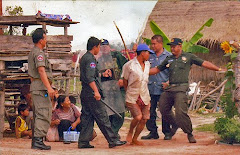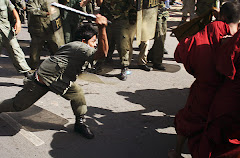BY: SOURN SEREY RATHA & BP
Cambodian Action Committee for Justice & Equity (CACJE)
Contact: sournsereyratha@gmail.com
The whole Son Tay incarceration facility was buried three meters deep underground. The whole facility was covert by a field of thatch with eight almost horizontal access doors of seventy centimeters width, one at each cardinal point. The door was open with a cranked system, well camouflaged under the thick thatch.
Contact: sournsereyratha@gmail.com
The whole Son Tay incarceration facility was buried three meters deep underground. The whole facility was covert by a field of thatch with eight almost horizontal access doors of seventy centimeters width, one at each cardinal point. The door was open with a cranked system, well camouflaged under the thick thatch.
There were hundred Cambodians who were prisoners at Son Tay. Only a few came out alive. Several years later, the most famous prisoners who came out alive after several years of incarceration were the former Prime Minister Pen Sovan and Col Ly Thieng Chek.
20. At the first half hour of Son Tay assault, the US Air support cannot help 1,100 Khmer Krom soldiers because of the very closeness of combat. The 1,100 fought alone to accomplish their mission. The North Vietnamese soldiers were far outnumbered Khmer Krom soldiers 1 to 20.
21. When Capt Chau Dara saw the two helicopters HH-53s “Apple 01 - 02” were taking off with all the Green Berets aboard and flew away toward Thailand, Capt Chau Dara was convinced that the helicopters would not come back to pick them. So, he led seven survivors of the 1,100 Khmer Krom and fled toward Cambodia by following the same path they had come into Son Tay. All the survivors were injured. They crossed the Song Con River on that very early morning by the nylon rope to the opposite Song Con River bank.
There, they waited for 36 hours for the other survivors. Their communication radios C-25 were fallen in the river, therefore impossible to repair. Then Capt Nao Eng threw it in the river.
Two other Cambodian raider survivors from Battalion 149 escaped by their own mean to Laos.
Four Cambodian raider survivors were badly injured with no medicine, no foods and especially no water. Their C-25 radios were out impossible to repair.
22. Khmer Krom Son Tay raider’s sacrifice was enormous.
Finally, of the 1,100 Khmer Krom Special Forces who participated in Son Tay Rescue Operation Kingpin, all in all, only five survived and arrived to Cambodia.
· All the Khmer Krom battalion 137 of 800 soldiers commanded by Capt Thach Hén was annihilated. All officers and privates of the Khmer Krom Battalion 137 volunteered for Son Tay Rescue Operation Kingpin were all killed. No survivor.
Capt Thach Hén had served the CIA for more than twenty-one years.
· Of the three hundred Kanseign Sar Son Tay raiders of the Battalion 149, only nine survived: (a) Seven Son Tay raider survivors would escape and flee to Cambodia under the direction of Capt Chau Dara. Of these seven survivors, four would suicide in midway, and (b) Two others survivors escaped by their own mean toward Lao.
· Indeed, Capt Hem Sim, Capt Kao Dob, Capt Kao Dorn and Capt Thach Loi of the Kanseign Sar Battalion 149 escaped and fled toward Cambodia under the direction of Capt Chau Dara, but they were all very badly injured.
After one month of escape, without medicine, food and essentially water, Capt Hem Sim, Capt Kao Dob, Capt Kao Dorn and Capt Thach Loi preferred the suicide in midway toward Cambodia with the special CIA two-bullets cigarette pistol. They fired themselves a bullet in their own head.
22. A Black Recon Team.
Almost two months later after the D-Day, after fleeing Son Tay, that’s one month after the suicide of their four colleagues in midway, the three remaining Cambodian Special Force Son Tay raider survivors led by Capt Chau Dara reached the South of Khe Sanh, Vietnam, near the junction of the three frontiers Cambodia, Laos and Vietnam.
They met there in the forest a Recon Team of five Black Americans soldiers and one guide Khmer Krom from South Vietnam.
It was Capt Nao Eng who discovered first the black officer who climbed the tree to call in a sanitary helicopter.
The American Recon Team did not see the Cambodian raiders. It was Capt Nao Eng who saw them first.
The black officer made a hand sign telling Cambodian survivors that he called in one helicopter.
This was the first time the Recon Black American team and the three Cambodian Son Tay raiders met together. They never met each other before. By using map and some special convened signs they convinced mutually they were friends.
The American Recon Team had medicine, foods and water. They shared all they have with the three Cambodian survivors. One black soldier was badly injured by booby trap. So they needed the sanitary extraction by helicopter.
The American Recon Team did not know very well the battleground of this area because they want to cross Ratanakiri province to reach an American base at Tay Ninh in South Vietnam.
You must not do that, advised Chau Dara. Then, Dara proposed to go first alone to check the Ratanakiri village situation. In effect Ratanakiri was infested of North Vietnamese soldiers. Several North Vietnamese divisions stationed there in preparation to attack the South Vietnam.
With this proof, Chau Dara successfully convinced the Recon Black American Team not the cross Ratatanakiri. Chau Dara advised them to direct their escape toward Stung Trèng then fly to Thailand. That’s what was done.
The Recon Black American Team had succeeded to contact one US helicopter to pick them all and land the three Khmer Krom Son Tay raiders at Stung Trèng. Then the helicopter flew the Recon Black American Team finally to Thailand.
The danger between Khe Sanh and Stung Trèng was so great because the minority ethnic in these remote villages were allied with the communist North Vietnam. They would signal any movement to the North Vietnam army. So the life of any escapee was in extreme danger.
24. Five years later, the Khmer Rouge communist took power in Cambodia, on April 17, 1975. Among the five survivors of the 1,100 Cambodian Special Force Son Tay raiders, Capt Nao Eng and Capt Chhin Saray will be murdered by the Khmer Rouge one yaer after the Khmer Rouge victory.
Capt Nao Eng refused to flee to Thailand after the Khmer Rouge Victory because of Son Tay Raid. The American had abandoned him at Son Tay.
A few months after Son Tay Rescue operation Kingpin, the North Vietnam soldiers rounded up all male population near Lang Hei, the nearby CIA Laotian town advanced post. They were about one hundred Cambodian men.
The North Vietnamese soldiers herded them toward Stung Treng, Northern Cambodian province, then crucified and nailed them all to the trees, and left them all die slowly and atrociously.
That was and still is the abominable North Vietnamese punishment to those who dared to oppose to Hanoi enslavement of Cambodia and Laos policy.
May 2008, two Cambodian KANSEIGN SAR Son Tay Raiders survivors, Capt Chau Dara Kanseign Sar Battalion 149 commander and Lt Thach Channy lived in the US and the third, Capt Thach Sareth lived in Cambodia. These three were the only survivors of the Cambodian component of Son Tay Rescue Operation Kingpin.
The 1,100 Cambodian KANSEIGN SAR and Khmer Krom raiders had left behind their wives and children who lived right now in Cambodia. Their lives are in very danger if the Vietnamese knew they were Kanseign Sar families. Kanseign Sar still continues to fight for freedom as always.
25. Financial Rewards
CIA Maj. Ed Neal has promised to KANSEIGN SAR Organization (Cambodian Special Forces organization) through Capt Thach Hén the reward of five million dollars for their participation to the Operation Kingpin.
Only the following people had received the compensation:
(1) About three hundred wives or parents of the 800 Khmer Krom soldiers of the Battalion 137 led by Capt Thach Hén, and
(2) One hundred wives of parents of the Kanseign Sar Battalion 149 soldiers led by Capt Chau Dara.
For an officer the reward was two thousand five hundred dollars ($2,500), and for the private four hundred fifty dollars (in US dollars of 1970).
Capt Chau Dara, Capt Nao Eng and Capt Chhin Saray had received twelve thousand five hundred dollars ($12,500) each. That’s all.
26. KANSEIGN SAR Special Forces Organization under the President of General Chau Dara needed your help to render justice for the ultimate sacrifice and to honor their soldiers for their defense of freedom and independence and democracy and in accomplishment with bravura and extreme sacrifice of their Rescue Kingpin Operation of Son Tay American POWs. Flesh, blood and tears of their sacrifice must not be forgotten.
Eleven hundred Kanseign Sar and Khmer Krom soldiers had sacrificed their life in Son Tay Rescue Operation Kingpin because Kanseign Sar and Khmer Krom had confidence that the United States would help Cambodia to fight against the totalitarianism, defend Cambodia sovereignty, independence, freedom and democracy and fight against the North Vietnamese swallow of Cambodia by forces.
Since the withdrawal of the US Armed Forces from Vietnam, the North Vietnamese Army hitherto occupied Cambodia. Hanoi policy was to swallow Cambodia.
The US and Vietnam were co-signatory of the November 23, 1991 Paris Peace Agreement on Cambodia. The US must oblige Hanoi to integrally respect the 1991 Paris Peace agreement on Cambodia which stipulated that Vietnam should withdraw all their armed forces from Cambodia. Up to these days, the People Army of Vietnam (PAVN) still occupied Cambodia.
27. For security reason, the names of the three Cambodian Raiders survivors of Son Tay Rescue Operation Kingpin are acronyms. The others are real, Please do contact Authors for your concerned...
The US and Vietnam were co-signatory of the November 23, 1991 Paris Peace Agreement on Cambodia. The US must oblige Hanoi to integrally respect the 1991 Paris Peace agreement on Cambodia which stipulated that Vietnam should withdraw all their armed forces from Cambodia. Up to these days, the People Army of Vietnam (PAVN) still occupied Cambodia.
27. For security reason, the names of the three Cambodian Raiders survivors of Son Tay Rescue Operation Kingpin are acronyms. The others are real, Please do contact Authors for your concerned...









